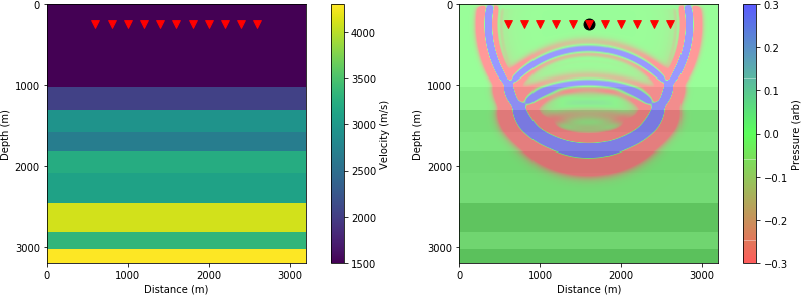This repository reproduces the results of the paper: Fast approximate simulation of seismic waves with deep learning, NeurIPS 2018, B. Moseley, A. Markham and T. Nissen-Meyer.
Our dataset is also provided, as well as a workshop Jupyter notebook showing examples on how to run this code.
-
Seismic simulation is crucial for many geophysical applications, yet traditional approaches are computationally expensive.
-
We use deep learning to simulate seismic waves.
-
We show that this can offer a fast approximate alternative to traditional simulation methods.
-
We are also able to adapt our network to carry out fast seismic inversion, by flipping its inputs and outputs.
For this proof of principle study, we consider the simulation of acoustic waves propagating in synthetic horizontally layered media.
Specifically, we consider a single fixed point source propagating through a horizonally layered velocity model with 11 fixed receivers horizontally offset from the source, shown below.
Left: input velocity model, triangles show receiver locations. Right: wavefield pressure after 1 s, using acoustic Finite-Difference (FD) modelling, black circle shows fixed point source location.
Our task is as follows:
Given a randomly selected layered velocity model as input, can we train a neural network to simulate the pressure response recorded at each receiver location?
We wish the network to generalise well to velocity models unseen during training.
We use the following workflow to complete this task;
-
we preprocess the input velocity profile into its corresponding reflectivity series;
-
we pass this to a deep neural network with a WaveNet architecture to simulate the receiver responses;
-
we train this network with many example ground truth FD simulations;
-
we compare the accuracy and computational performance of the trained network to FD simulation.
Our workflow is shown below.
seismic-simulation-wavenet only requires Python libraries to run. We recommend setting up an new environment, for example:
conda create -n workshop python=3.6 # Use Anaconda package manager
source activate workshopand then installing the following dependencies:
pip install --ignore-installed --upgrade [packageURL]# install tensorflow (get packageURL from https://www.tensorflow.org/install/pip, see tensorflow website for details)
pip install tqdm requests
conda install matplotlib jupyterPlease ensure you install Tensorflow version 1.10 or above.
Then download the source code:
git clone https://github.com/benmoseley/seismic-simulation-wavenet.gitA SeismicWavenet model can be trained very easily using the following code snippet:
# define model hyperparameters
c = constants.Constants()
c["NUM_WAVE_BLOCKS"] = 1# number of WaveNet blocks to use
c["WAVE_HIDDEN_CHANNELS"] = 256# number of hidden channels in WaveNet
c["WAVE_RATES"] = [1,2,4,8,16,32,64,128,256]# dilation rates for each convolutional layer
c["WAVE_BIASES"] = False# whether to use biases in the WaveNet
c["WAVE_ACTIVATION"] = tf.nn.relu# activation function
c["CONV_FILTER_LENGTH"] = 101# filter length of the final output convolutional layer
run = main.Trainer(c)
run.train()Take a look at the workshop notebook provided here for more examples.


